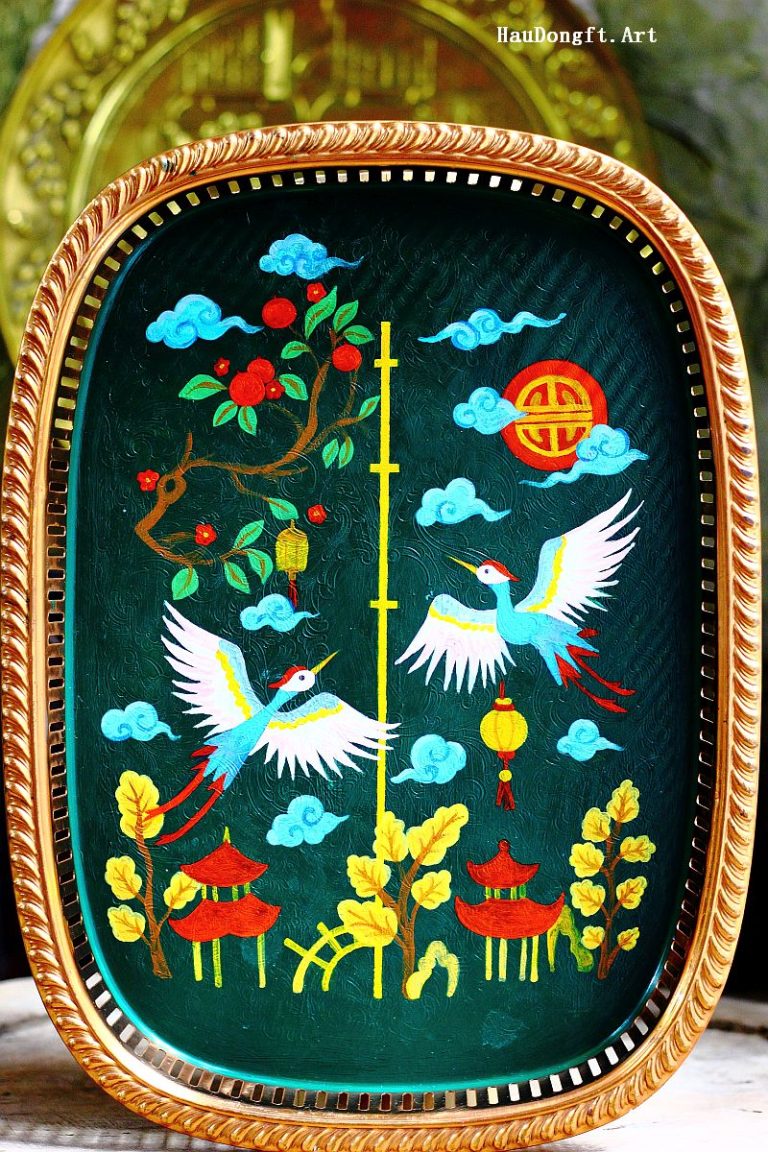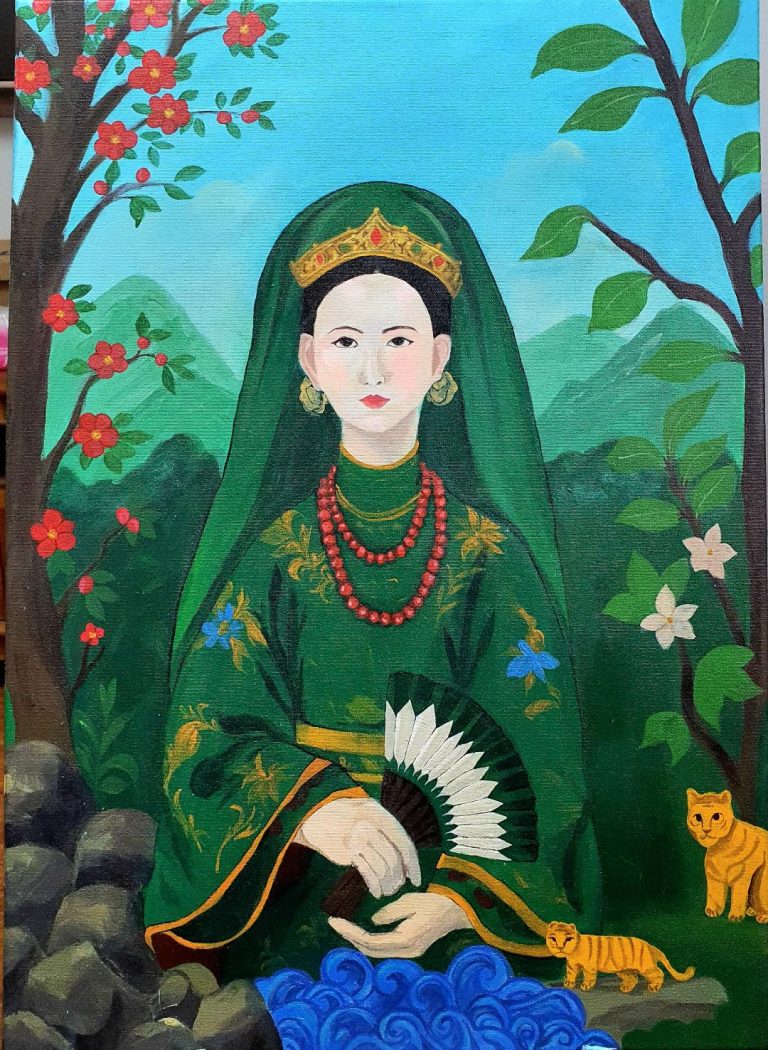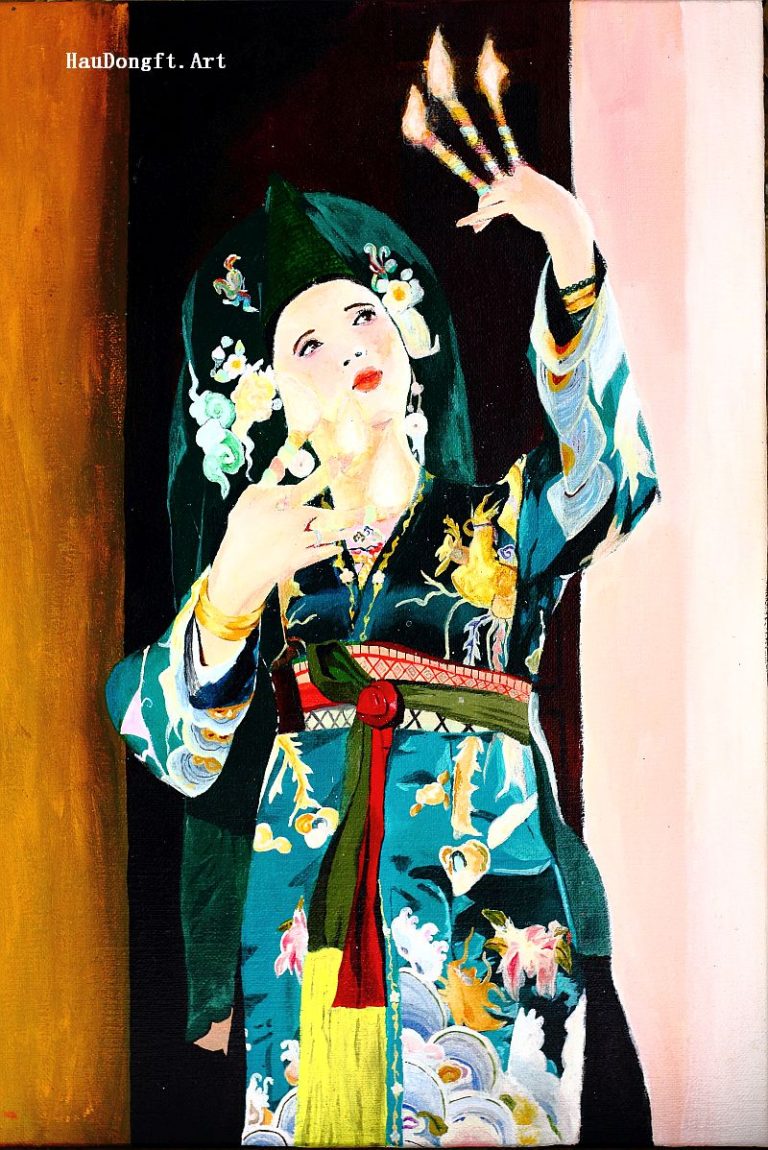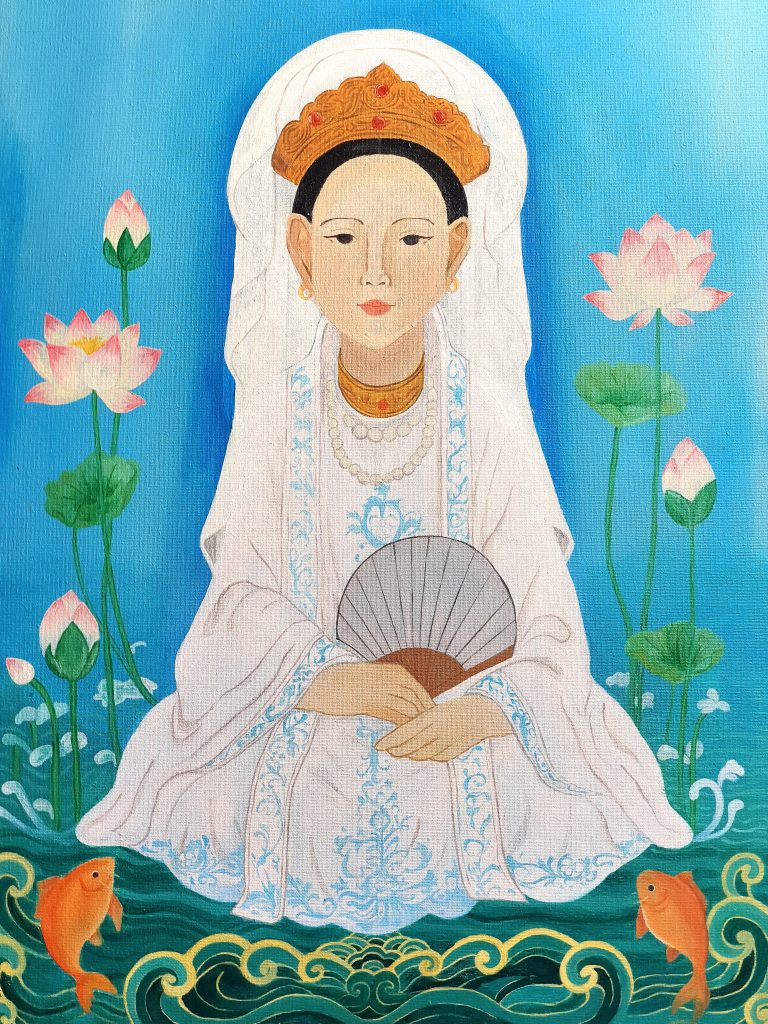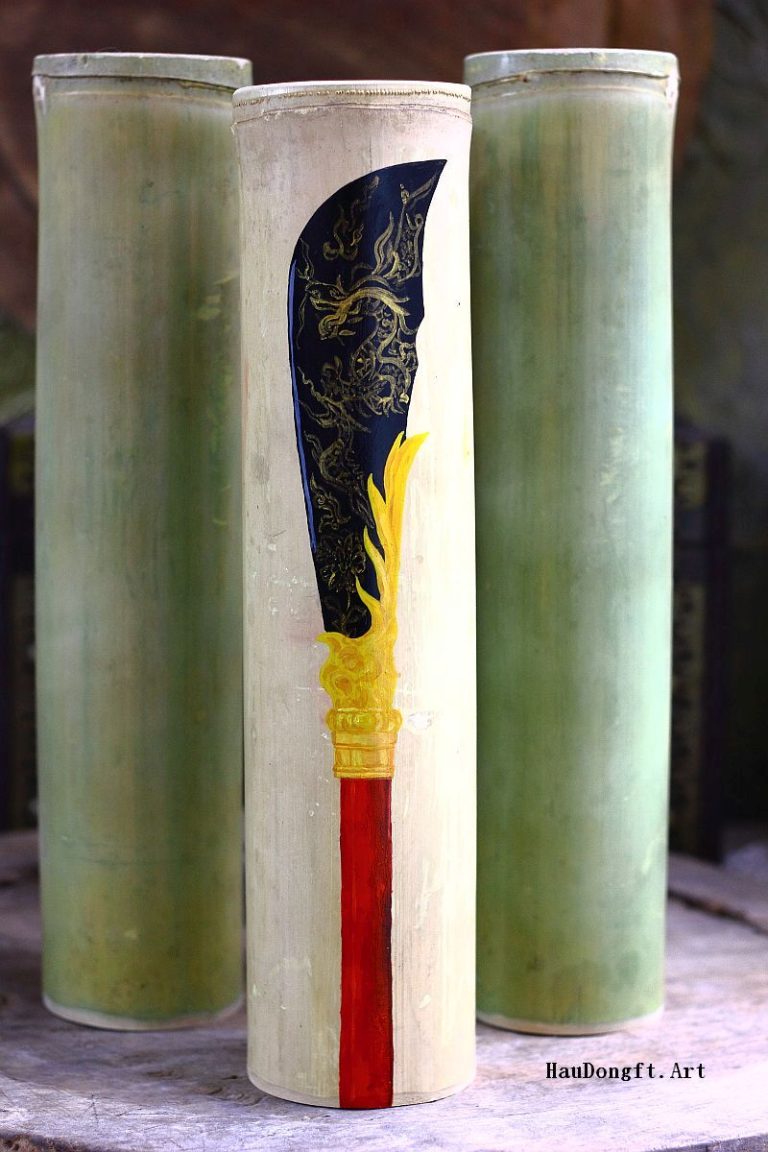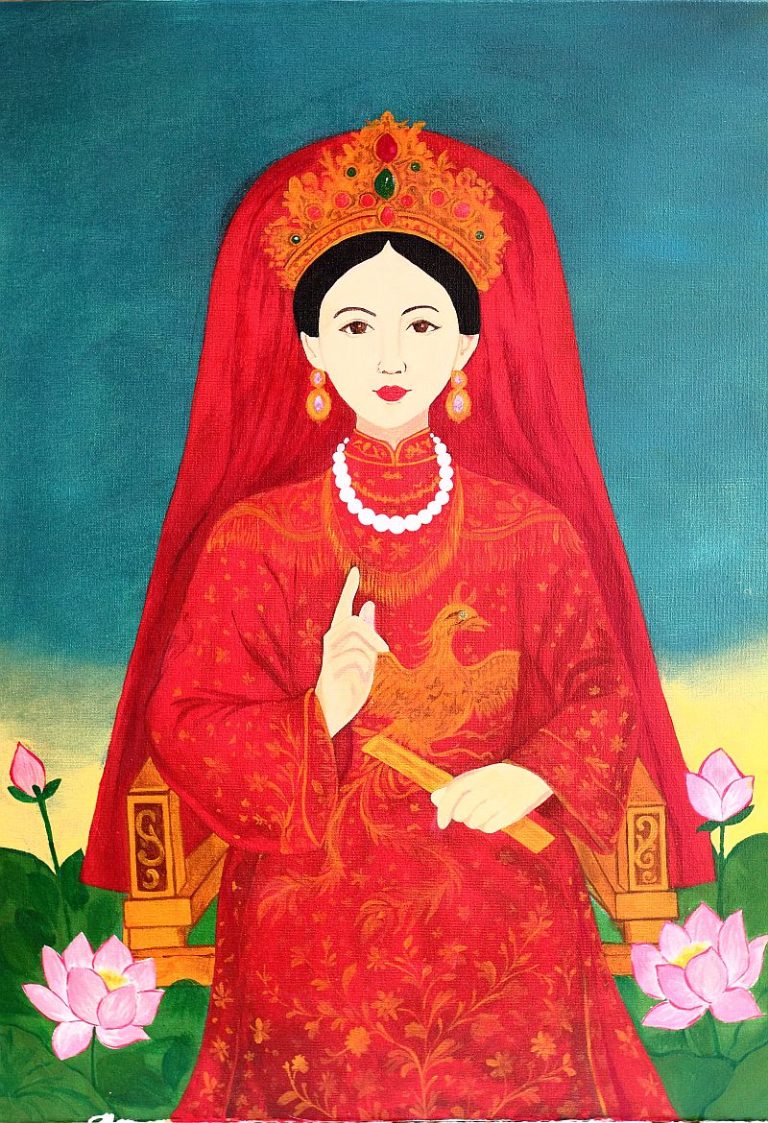Vietnam’s Mother Goddess Worship (Đạo Mẫu) was inscribed by UNESCO in December 2016 as an Intangible Cultural Heritage of Humanity. When speaking of this tradition, one cannot fail to mention the ritual of lên đồng (spirit possession), a unique, mystical, and theatrical practice—from costumes to performance process—rooted in the belief that the thanh đồng (spirit medium) can communicate with the deities and embody their presence.
This article offers an initial survey and interpretation of the significance of the costumes worn by spirit mediums during the ritual, as well as the transformations in costume design and form over the past decade.
The Ritual of Lên đồng and the Spirit Medium
In the limited space of a temple, the lên đồng ritual unfolds within a dazzling setting, where ritual offerings (fruits, incense, flowers, lamps, candles, votive objects) combine with the opulent costumes of the mediums. The result is an overwhelming sensory impression: vibrant contrasts of color in the altar decorations, elaborate costumes, captivating dance movements, and music.
But what, in essence, is lên đồng? Who is the thanh đồng? And how is the beauty of their costume linked to the power of the deities they embody?
The ritual has been described variously as “multiple possessions by deities,” a “phenomenon of religious psychology,” or even a “heterodox cult.” These represent three main scholarly approaches to its nature. The practice is also known by other terms: hầu đồng, hầu bóng, or ngồi đồng. These familiar names all point to a central ritual of the cult of Trần Hưng Đạo (Saint Trần) and the Mother Goddess Liễu Hạnh in the Red River Delta.
The thanh đồng, the central actor of the ritual, performs the dance as the “body” through which the deities “descend” or “enter.” The body, therefore, must be clothed according to the prescribed costume of each deity invoked. In this way, aesthetic conceptions in Mother Goddess Worship differ markedly from everyday dress. The ritual process, offerings, and costumes are indispensable expressions of faith. After each trance performance (giá hầu), the deities are believed to bestow blessings and fortune upon devotees. Within this sacred atmosphere, however elusive, both mediums and participants feel they receive divine energy and power.
Costumes of the Spirit Medium
In early spring 2025 at Hương Nghĩa Temple (Hanoi), we attended a lên đồng ceremony where the medium was a middle aged man from Hanoi. After the invocation chants, the boy appeared in simple white attire and sat upon the ritual mat. The ceremony began. Two attendants dressed him in a golden áo dài embroidered with a glittering coiled dragon, with two flags tucked behind his back. As the musicians sang to announce that Lady Cô Đôi of the Trần lineage had entered, the boy began to dance.
One by one, he changed costumes: the Second Mandarin (Quan Đệ Nhị) in sky-blue áo dài, yellow trousers, red sash, and turban; the Third Mandarin (Quan Đệ Tam) in a white áo dài with red sash; the Fourth Mandarin (Quan Đệ Tứ) in yellow; the Fifth Mandarin (Quan Đệ Ngũ Tuần Tranh) in dark blue—all marked by signs of possession and departure.
Subsequent sequences included the Dames (Chầu Bà), adorned with phoenix and peacock embroidery: the 2nd Dame in teal áo dài with ethnic Thái skirt; the 6th Dame in purple-pink áo dài with red sash and leggings; Little Dame Đồng Mỏ in golden áo dài with yellow turban and fan; Little Dame Bắc Lệ in black Mông ethnic attire with horn-shaped headscarf.
The Princes (Ông Hoàng) wore dragon and seal motifs once reserved for royalty: Prince Hoàng Bơ in white áo dài with wide golden sash; Prince Hoàng Bảy in dark blue áo dài with green cloak; Prince Hoàng Mười in golden áo dài with turban.
The Maidens (Cô) and Youths (Cậu) followed, dressed in brilliant colors: Maiden Cô Đôi Thượng in pale green voile with jewelry; Maiden Cô Bơ in white voile áo dài with boat-dance performance; Maiden Cô Sáu Sơn Trang in ethnic-style attire with bells; Maiden Cô Chín Bói in Northern four-panel gown with traditional headscarf and carrying baskets. The final sequence was Little Prince Cậu Bé Thượng, dressed like a young boy in green vest and headband.
Remarkably, this six-year-old medium performed all 18 trance sequences in a single session.
According to scholars, a key moment of the ritual is when attendants cover the medium’s head with a red veil (khăn phủ diện), symbolizing the descent or departure of the deities—a sign of divine rebirth within the body of the medium. Red also plays a psychological role, heightening trance through its combination with sound, dance, and incense.
Because all deities manifest through the single body of the medium, costume becomes crucial. Each outfit symbolizes the appearance and power of the deity while distinguishing their hierarchical rank. The supreme deity is the Jade Emperor, followed by the Three Mother Goddesses (Tam Tòa Thánh Mẫu)—Heaven (red), Mountains and Forests (green), Waters (white). Then come the Five Mandarins (Ngũ Vị Vương Quan), the Four Ladies (Tứ Vị Chầu Bà), the Five Princes (Ngũ Vị Hoàng Tử), the Twelve Maidens (Thập Nhị Vương Cô), the Twelve Youths (Thập Nhị Vương Cậu), and protective spirits such as the Five Tiger Generals and Ông Lốt (Sacred Serpent).
The costumes feature embroidered dragons, phoenixes, qilin, turtles, stylized clouds, chrysanthemums, tiger faces, and scroll motifs—always in dazzling colors. This brilliance is thought to attract the attention of the deities, facilitating possession. Yet, strict conventions still apply: each deity has designated colors, regional styles, and embroidery motifs. Costumes thus embody both beauty and the hierarchy of divine authority.
Beauty and Power in the Aesthetics of Medium Costumes
From field observations, we found that while costumes are elaborate, each medium expresses personal aesthetic taste. Most outfits are commissioned from embroidery villages in Thường Tín or purchased at Hàng Quạt Street in Hanoi. Some mediums favor luxurious brocade, velvet, and hand embroidery; others prefer simpler designs, respecting only the required colors.
At Phủ Dầy and Phủ Nấp, we observed striking variations: the same trance sequence for Mandarin Đệ Tam was performed by two mediums—one in Vĩnh Lộc (Đồng Nai) in a hand-embroidered dragon robe, the other in Nam Định in a machine-embroidered version on different fabric. Similarly, costumes for Maiden Cô Bé Đông Cuông may use traditional Mông attire with basket, but individual choice and wealth determine whether to add embroidered motifs or jewelry.
Mediums acknowledge this openly. One said: “Costumes are widely available; we choose what we like, depending on our means.” Another explained: “The sequence is fixed by tradition, but material and embroidery depend on one’s finances and taste.”
As Professor Ngô Đức Thịnh noted, the practice has been partly “royalized.” Dragons on Mandarins’ robes once symbolized emperors; phoenix and peacock motifs marked queens and noblewomen; seal motifs and auspicious Chinese characters were reserved for princes. Artisans in embroidery villages also confirmed strict rules distinguishing ranks through motifs.
Thus, costume both displays aesthetic refinement and functions as a visible marker of divine hierarchy. It also reveals social hierarchy among mediums: the wealthy commission handmade silk robes with intricate embroidery, while poorer mediums rely on cheaper, machine-made garments that lack brilliance. This difference affects both perceived beauty and symbolic authority.
Accessories—jewelry, headdresses, scarves, ornaments—are equally important. Their arrangement depends on the attendants (hầu dâng), who prepare the medium and shape their appearance. Many mediums believe attendants too receive blessings from the deities and hold power in enhancing the medium’s beauty and authority, since not all mediums are skilled at self-adornment.
Ultimately, the beauty of the costume is inseparable from its symbolic power. For mediums, dressing in radiant, majestic garments is not only aesthetic but a sacred act, enabling divine embodiment and sustaining the practice of faith. The khăn chầu, áo ngự (ceremonial costumes) are therefore not mere decoration; they affirm rank, inspire awe, express devotion, and ensure the vitality of Mother Goddess Worship in contemporary Vietnam.
